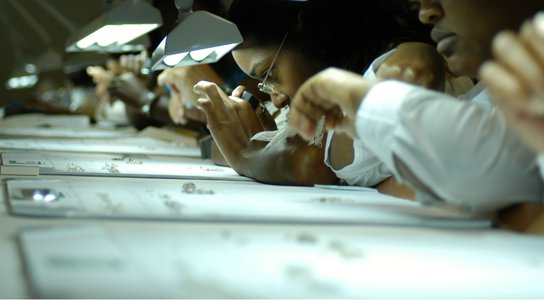The body that represents the global diamond sector, the World Diamond Council (WDC), has issued not one but two statements in recent weeks that acknowledge serious human rights concerns in the sector and indicate a shift towards greater transparency in what has been a notoriously opaque industry.
These statements represent the diamond industry’s strongest critique yet of the government-led certification scheme, the Kimberley Process (KP), in recognition of its failure to break links between diamonds and human rights abuses. Alongside this acknowledgement, the WDC highlights the critical need for industry itself to take steps towards responsible diamond sourcing.
Industry taking responsibility for dealing with the risks linked to the diamond trade could have real impact, but only if the companies back up the latest pledges with action. It remains to be seen if these recent releases are empty words intended to burnish the sectors tarnished image or if they represent a genuine and welcome shift towards recognition that the diamond industry must embrace transparent and responsible business conduct.
Will the diamond industry get its own house in order?
It is particularly notable that in its recent statements the WDC has committed to leading transparency and business conduct from within its ranks. It stated that ‘while it waits for action from the Kimberley Process’ (a cynic might say don’t hold your breath), ‘the WDC is already conducting reforms of its own, to enable at the industry-level the type of progress it is advocating in the KP’.
This suggests that the industry is coming to realise that burying its head in the sand, or indeed hiding behind the KP, is not a durable solution. Of course the WDC can exert pressure on governments to affect KP reform and good luck to it. But it needs to focus on getting its own house in order, because KP reform or no reform, the international responsible sourcing conversation has moved on to a focus on company responsibility that isn’t going away.
International consensus has in recent years solidified around the responsibility of individual companies to respect human rights and take measures throughout international minerals and precious stone supply chains to ensure they are doing so. The OECD due diligence guidance, established in 2012, has long been regarded as the highest international standard which companies must meet in order to demonstrate that they take their human rights responsibilities seriously, and are addressing them meaningfully– including those in the diamond sector.
No longer hiding behind the Kimberley Process
In its statement the WDC urged reform of the KP, to cover a much broader range of human rights abuses than it currently does. It followed this up by welcoming the adoption of a UN General Assembly resolution that ‘encourages further strengthening of the Kimberley Process…to ensure…it remains relevant’.
Calls to reform the beleaguered KP
are nothing new. Consumers buying diamonds with a KP certificate who believe
the scheme provides assurance their diamond has not funded human rights abuses
are labouring under illusions. Civil society organisations have made overtures
to reform the certification scheme for almost a decade now*, showing that it is
simply not
up to the job. It’s pretty revealing that the diamond industry itself has
finally taken up the same message.
Although it’s good to see the WDC recognising the weaknesses of the KP, both historical and more contemporary developments strongly suggest that the diamond industry’s energy would be much better spent on reforming its own behaviour.
While the KP has stumbled on over the years, those of us concerned with genuinely changing the way that diamond supply chains operate in practice have turned our attention in the direction of the company’s themselves, in line with international norms detailing their responsibility to act. Signs they are beginning to sit up and take notice are encouraging, if only a first step.
The diamond industry must walk the talk
Consumers are increasingly conscious of the journey that brings the products they buy to market, including what production and trade really looks like. There’s only so long that they will be fooled by industry PR narratives that paint a rosy picture of the diamond industry: the grim reality of much of the world’s diamond mining, its environmental and climate impacts and its human rights implications is no longer an open secret: it’s a known fact.
So it’s about time that the wealthy diamond sector, regardless of its affluent and elegant marketing machine, got transparent about what its business impacts really look like and begin changing them for the better – from the inside.
We welcome the WDC’s latest
statements as a sign that the diamond sector is finally moving in that
direction – but the real test is whether this will translate into industry
action.
* While Global Witness was originally part of the KP, we stepped away in 2011 after years of attempting to enact change within a certification scheme severely hamstrung by its limited definition of ‘conflict diamonds’ to ‘rough diamonds used by rebel movements to finance wars against legitimate governments’. On top of this, a consensus-based government decision-making process leaves the KP’s ability to address serious human rights issues at the mercy of politics and frequently renders it unable to respond to urgent situations with alacrity or agility.


